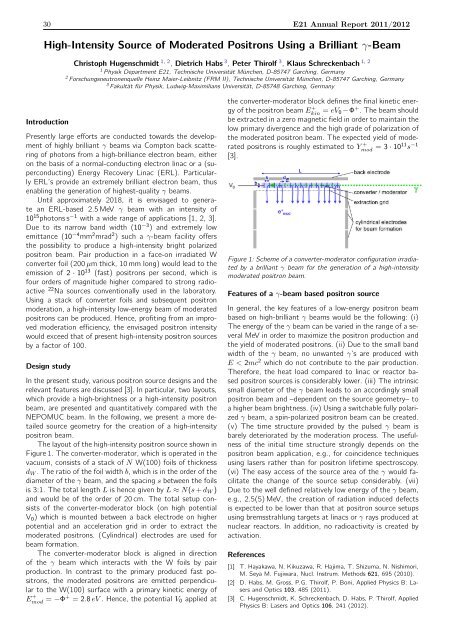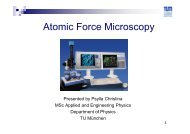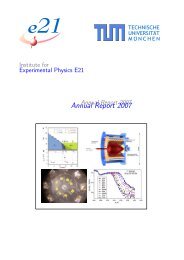Annual Report 2011 / 2012 - E21 - Technische Universität München
Annual Report 2011 / 2012 - E21 - Technische Universität München
Annual Report 2011 / 2012 - E21 - Technische Universität München
You also want an ePaper? Increase the reach of your titles
YUMPU automatically turns print PDFs into web optimized ePapers that Google loves.
30 <strong>E21</strong> <strong>Annual</strong> <strong>Report</strong> <strong>2011</strong>/<strong>2012</strong><br />
High-Intensity Source of Moderated Positrons Using a Brilliant γ-Beam<br />
Christoph Hugenschmidt 1, 2 , Dietrich Habs 3 , Peter Thirolf 3 , Klaus Schreckenbach 1, 2<br />
1 Physik Department <strong>E21</strong>, <strong>Technische</strong> Universität München, D-85747 Garching, Germany<br />
2 Forschungsneutronenquelle Heinz Maier-Leibnitz (FRM II), <strong>Technische</strong> Universität München, D-85747 Garching, Germany<br />
3 Fakultät für Physik, Ludwig-Maximilians Universität, D-85748 Garching, Germany<br />
Introduction<br />
Presently large efforts are conducted towards the development<br />
of highly brilliant γ beams via Compton back scattering<br />
of photons from a high-brilliance electron beam, either<br />
on the basis of a normal-conducting electron linac or a (superconducting)<br />
Energy Recovery Linac (ERL). Particularly<br />
ERL’s provide an extremely brilliant electron beam, thus<br />
enabling the generation of highest-quality γ beams.<br />
Until approximately 2018, it is envisaged to generate<br />
an ERL-based 2.5 MeV γ beam with an intensity of<br />
10 15 photons s −1 with a wide range of applications [1, 2, 3].<br />
Due to its narrow band width (10 −3 ) and extremely low<br />
emittance (10 −4 mm 2 mrad 2 ) such a γ-beam facility offers<br />
the possibility to produce a high-intensity bright polarized<br />
positron beam. Pair production in a face-on irradiated W<br />
converter foil (200µm thick, 10 mm long) would lead to the<br />
emission of 2 · 10 13 (fast) positrons per second, which is<br />
four orders of magnitude higher compared to strong radioactive<br />
22 Na sources conventionally used in the laboratory.<br />
Using a stack of converter foils and subsequent positron<br />
moderation, a high-intensity low-energy beam of moderated<br />
positrons can be produced. Hence, profiting from an improved<br />
moderation efficiency, the envisaged positron intensity<br />
would exceed that of present high-intensity positron sources<br />
by a factor of 100.<br />
Design study<br />
In the present study, various positron source designs and the<br />
relevant features are discussed [3]. In particular, two layouts,<br />
which provide a high-brightness or a high-intensity positron<br />
beam, are presented and quantitatively compared with the<br />
NEPOMUC beam. In the following, we present a more detailed<br />
source geometry for the creation of a high-intensity<br />
positron beam.<br />
The layout of the high-intensity positron source shown in<br />
Figure 1. The converter-moderator, which is operated in the<br />
vacuum, consists of a stack of N W(100) foils of thickness<br />
d W . The ratio of the foil width b, which is in the order of the<br />
diameter of the γ beam, and the spacing s between the foils<br />
is 3:1. The total length L is hence given by L ≈ N(s+d W )<br />
and would be of the order of 20 cm. The total setup consists<br />
of the converter-moderator block (on high potential<br />
V 0 ) which is mounted between a back electrode on higher<br />
potential and an acceleration grid in order to extract the<br />
moderated positrons. (Cylindrical) electrodes are used for<br />
beam formation.<br />
The converter-moderator block is aligned in direction<br />
of the γ beam which interacts with the W foils by pair<br />
production. In contrast to the primary produced fast positrons,<br />
the moderated positrons are emitted perpendicular<br />
to the W(100) surface with a primary kinetic energy of<br />
E + mod = −Φ+ = 2.8eV . Hence, the potential V 0 applied at<br />
the converter-moderator block defines the final kinetic energy<br />
of the positron beam E + kin = eV 0−Φ + . The beam should<br />
be extracted in a zero magnetic field in order to maintain the<br />
low primary divergence and the high grade of polarization of<br />
the moderated positron beam. The expected yield of moderated<br />
positrons is roughly estimated to Y + mod = 3·1011 s −1<br />
[3].<br />
Figure 1: Scheme of a converter-moderator configuration irradiated<br />
by a brilliant γ beam for the generation of a high-intensity<br />
moderated positron beam.<br />
Features of a γ-beam based positron source<br />
In general, the key features of a low-energy positron beam<br />
based on high-brilliant γ beams would be the following: (i)<br />
The energy of the γ beam can be varied in the range of a several<br />
MeV in order to maximize the positron production and<br />
the yield of moderated positrons. (ii) Due to the small band<br />
width of the γ beam, no unwanted γ’s are produced with<br />
E < 2mc 2 which do not contribute to the pair production.<br />
Therefore, the heat load compared to linac or reactor based<br />
positron sources is considerably lower. (iii) The intrinsic<br />
small diameter of the γ beam leads to an accordingly small<br />
positron beam and –dependent on the source geometry– to<br />
a higher beam brightness. (iv) Using a switchable fully polarized<br />
γ beam, a spin-polarized positron beam can be created.<br />
(v) The time structure provided by the pulsed γ beam is<br />
barely deteriorated by the moderation process. The usefulness<br />
of the initial time structure strongly depends on the<br />
positron beam application, e.g., for coincidence techniques<br />
using lasers rather than for positron lifetime spectroscopy.<br />
(vi) The easy access of the source area of the γ would facilitate<br />
the change of the source setup considerably. (vii)<br />
Due to the well defined relatively low energy of the γ beam,<br />
e.g., 2.5(5) MeV, the creation of radiation induced defects<br />
is expected to be lower than that at positron source setups<br />
using bremsstrahlung targets at linacs or γ rays produced at<br />
nuclear reactors. In addition, no radioactivity is created by<br />
activation.<br />
References<br />
[1] T. Hayakawa, N. Kikuzawa, R. Hajima, T. Shizuma, N. Nishimori,<br />
M. Seya M. Fujiwara, Nucl. Instrum. Methods 621, 695 (2010).<br />
[2] D. Habs, M. Gross, P.G. Thirolf, P. Boni, Applied Physics B: Lasers<br />
and Optics 103, 485 (<strong>2011</strong>).<br />
[3] C. Hugenschmidt, K. Schreckenbach, D. Habs, P. Thirolf, Applied<br />
Physics B: Lasers and Optics 106, 241 (<strong>2012</strong>).




